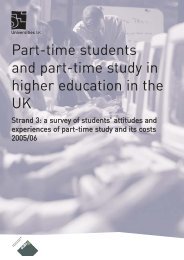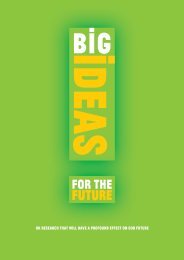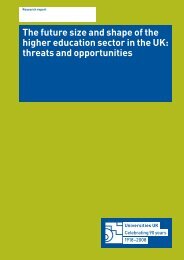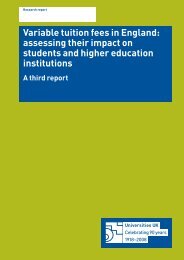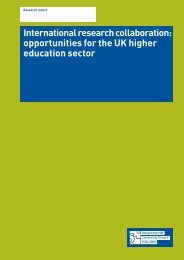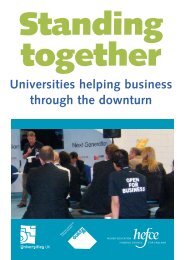<strong>Creat<strong>in</strong>g</strong> <strong>Prosperity</strong>: <strong>the</strong> <strong>role</strong> <strong>of</strong> <strong>higher</strong> <strong>education</strong><strong>in</strong> driv<strong>in</strong>g <strong>the</strong> <strong>UK</strong>’s creative economy344.59 It is also important to note that universities do not move. They have a consistent location with<strong>in</strong> <strong>the</strong>irregions and, as such, <strong>of</strong>fer a degree <strong>of</strong> permanence that allows <strong>the</strong>m to act as key anchors <strong>of</strong> localand regional clusters through <strong>the</strong>ir ability to attract and reta<strong>in</strong> graduate and academic talent as wellas bus<strong>in</strong>esses. They are ‘sticky places <strong>in</strong> slippery space’ (Markusen, 1996).q‘With MMU we have a lead<strong>in</strong>g edge, academically rigorous partner to achieve our aspiration <strong>of</strong> develop<strong>in</strong>g worldclass, digitally <strong>in</strong>tegrated marketers <strong>of</strong> tomorrow. The programme <strong>the</strong>y have put toge<strong>the</strong>r is superb.’Mark Kelly, McCann-Erickson Communications House4.60 The <strong>role</strong> <strong>of</strong> universities as centres <strong>of</strong> regional <strong>in</strong>novation <strong>the</strong>refore needs to be reflected <strong>in</strong> <strong>the</strong>develop<strong>in</strong>g LEP structures across England where, as well as be<strong>in</strong>g large organisations <strong>in</strong> <strong>the</strong>irown right, universities can help anchor and stimulate local economies.4.61 The scale, credibility and reputation <strong>of</strong> universities also allows <strong>the</strong>m to engage major <strong>in</strong>dustry playersand facilitate l<strong>in</strong>ks to creative SMEs, creat<strong>in</strong>g new connections and bus<strong>in</strong>ess opportunities that wouldnot o<strong>the</strong>rwise be feasible. Large research-led <strong>in</strong>itiatives such as <strong>the</strong> Horizon Digital Economy Hub andDigilab are actively engag<strong>in</strong>g <strong>in</strong>ternational bus<strong>in</strong>esses, lever<strong>in</strong>g resources and br<strong>in</strong>g<strong>in</strong>g significant<strong>in</strong>dustry players <strong>in</strong>to regional clusters.4.62 <strong>Universities</strong> can also have catalytic effects on regional <strong>in</strong>dustry growth, rais<strong>in</strong>g <strong>the</strong> pr<strong>of</strong>ile <strong>of</strong> <strong>the</strong>creative economy at national and <strong>in</strong>ternational levels and showcas<strong>in</strong>g <strong>UK</strong> talent. For example, <strong>the</strong>Anglo-Japanese Textile Research Centre at <strong>the</strong> University for <strong>the</strong> Creative Arts (see below) hashelped to build strong l<strong>in</strong>ks to <strong>the</strong> Japanese market for students and graduate talent, and <strong>the</strong>Serious Games Institute has established <strong>the</strong> <strong>UK</strong> as a lead<strong>in</strong>g force <strong>in</strong> <strong>the</strong> serious gamesmarket, secur<strong>in</strong>g <strong>in</strong>ternational contracts for tenant bus<strong>in</strong>esses.10. CASE STUDYThe Anglo-Japanese TextileResearch CentreThe Anglo-Japanese Textile Research Centrewas set up <strong>in</strong> 2004 as an outcome <strong>of</strong> an AHRBFellowship. It was developed as a response to<strong>the</strong> pressures on <strong>the</strong> <strong>UK</strong> textile <strong>in</strong>dustry andan identified gap <strong>in</strong> <strong>the</strong> market for an <strong>in</strong>itiativethat prioritised contemporary textile practiceand engaged with <strong>the</strong> Japanese market.A number <strong>of</strong> partners are <strong>in</strong>volved, <strong>in</strong>clud<strong>in</strong>glarge commercial companies such as NUNOand Blue Pr<strong>in</strong>t, as well as universities, localauthorities and embassies. <strong>Universities</strong> <strong>in</strong> <strong>the</strong><strong>UK</strong> become <strong>in</strong>volved <strong>in</strong> <strong>the</strong> project throughhost<strong>in</strong>g workshops for visit<strong>in</strong>g practitionersfrom Japan and elsewhere <strong>in</strong> <strong>the</strong> <strong>UK</strong>. The localauthorities support work<strong>in</strong>g with schools andlocal bus<strong>in</strong>esses.The <strong>in</strong>itiative is funded through <strong>the</strong> researchfund and externally by appropriate fund<strong>in</strong>gbodies (as appropriate for specific projects,for example research fund<strong>in</strong>g bodies) andcommercial sponsorship, which helps toachieve greater publication values. Thetotal budget for <strong>the</strong> activities from 2004to date is circa £500,000 (exclud<strong>in</strong>g <strong>in</strong>k<strong>in</strong>dcontributions).The AJTRC is not a purpose-built centre,ra<strong>the</strong>r it is based with<strong>in</strong> <strong>the</strong> university andcomprises four PhD students, and researchstaff (a core <strong>of</strong> three, although this could bemore depend<strong>in</strong>g on <strong>the</strong> project). It has helpedto raise <strong>the</strong> pr<strong>of</strong>ile <strong>of</strong> <strong>the</strong> University and is agood recruitment tool for students, especiallyat postgraduate and PhD level. It also helpsto connect <strong>the</strong> University nationally and<strong>in</strong>ternationally and enhances <strong>the</strong> portfolio<strong>of</strong> relationships with bus<strong>in</strong>esses <strong>in</strong> <strong>the</strong>creative economy.4.0 Higher <strong>education</strong>’s contribution
<strong>Creat<strong>in</strong>g</strong> <strong>Prosperity</strong>: <strong>the</strong> <strong>role</strong> <strong>of</strong> <strong>higher</strong> <strong>education</strong><strong>in</strong> driv<strong>in</strong>g <strong>the</strong> <strong>UK</strong>’s creative economy35q‘The Anglo-Japanese projects have added value to our work <strong>in</strong> a unique way. Rarely do you get to work with o<strong>the</strong>rdesigners, <strong>in</strong> o<strong>the</strong>r fields, <strong>in</strong> o<strong>the</strong>r countries, over an extended period <strong>of</strong> time. Rarely do you have <strong>the</strong> opportunity toga<strong>in</strong> <strong>the</strong>ir respect, trust and friendship. Rarely do you have <strong>the</strong> opportunity to design and publish such fasc<strong>in</strong>at<strong>in</strong>gimages and <strong>in</strong>formation. In a harder commercial world where we normally operate, it is uplift<strong>in</strong>g.’Gerry Diebel, Direct DesignProposition 4.Higher <strong>education</strong> is <strong>the</strong> primary source <strong>of</strong> talent for <strong>the</strong> creative economy.• Higher <strong>education</strong> has a crucial <strong>role</strong> <strong>in</strong> develop<strong>in</strong>g <strong>the</strong> next generation <strong>of</strong> talent that will drive<strong>in</strong>novation and growth <strong>in</strong> <strong>the</strong> creative economy.• There is evidence <strong>of</strong> <strong>in</strong>creas<strong>in</strong>g <strong>in</strong>dustry engagement at all stages <strong>of</strong> <strong>the</strong> <strong>education</strong> process,from course design to delivery.• Evidence suggests greater emphasis on multidiscipl<strong>in</strong>ary <strong>education</strong>, particularly atpostgraduate level, aga<strong>in</strong> underm<strong>in</strong><strong>in</strong>g <strong>the</strong> false dist<strong>in</strong>ction between STEM andcreative discipl<strong>in</strong>es.• There is a persistent mismatch between <strong>in</strong>dustry expectations and <strong>higher</strong> <strong>education</strong>’sunderstand<strong>in</strong>g <strong>of</strong> its <strong>role</strong> <strong>in</strong> develop<strong>in</strong>g graduates, and this needs to be addressed.• It is important to recognise <strong>the</strong> high unit costs <strong>of</strong> learn<strong>in</strong>g <strong>in</strong> some <strong>of</strong> <strong>the</strong> creative discipl<strong>in</strong>esas well as <strong>the</strong>ir economic and social value.4.63 As shown previously (Figure 2.1), <strong>the</strong> proportion <strong>of</strong> employees who are graduates is greater for<strong>the</strong> creative <strong>in</strong>dustries than for <strong>the</strong> <strong>UK</strong> workforce as a whole. Therefore, ensur<strong>in</strong>g a steady supply<strong>of</strong> suitable graduates is <strong>of</strong> vital importance.4.64 In order to provide a review <strong>of</strong> <strong>higher</strong> <strong>education</strong>’s core <strong>education</strong> activities <strong>in</strong> this area, we conductedan analysis <strong>of</strong> data from <strong>the</strong> <strong>Universities</strong> and Colleges Admissions Service (UCAS) and <strong>the</strong> HigherEducation Statistics Agency (HESA). We def<strong>in</strong>ed subjects related to <strong>the</strong> creative economy to <strong>in</strong>cludesome, but not all, subjects with<strong>in</strong> <strong>the</strong> broad categories with<strong>in</strong> <strong>the</strong> Jo<strong>in</strong>t Academic ClassificationSystem (JACS) (see Appendix C for a def<strong>in</strong>ition).4.65 Us<strong>in</strong>g this def<strong>in</strong>ition, <strong>in</strong> 2008/09 <strong>the</strong>re were just over 390,000 students <strong>in</strong> 5,054 courses <strong>in</strong> subjectsrelated to <strong>the</strong> creative economy. This accounted for approximately 16 per cent <strong>of</strong> <strong>the</strong> total studentpopulation. Even assum<strong>in</strong>g that not all will pursue careers with<strong>in</strong> <strong>the</strong> creative <strong>in</strong>dustries (<strong>in</strong>deed, asnoted earlier, creative graduates can be found <strong>in</strong> work<strong>in</strong>g right across <strong>the</strong> economy), this is stilla clear <strong>in</strong>dication <strong>of</strong> <strong>the</strong> scale <strong>of</strong> <strong>higher</strong> <strong>education</strong>’s contribution to <strong>the</strong> sector.4.0 Higher <strong>education</strong>’s contribution






